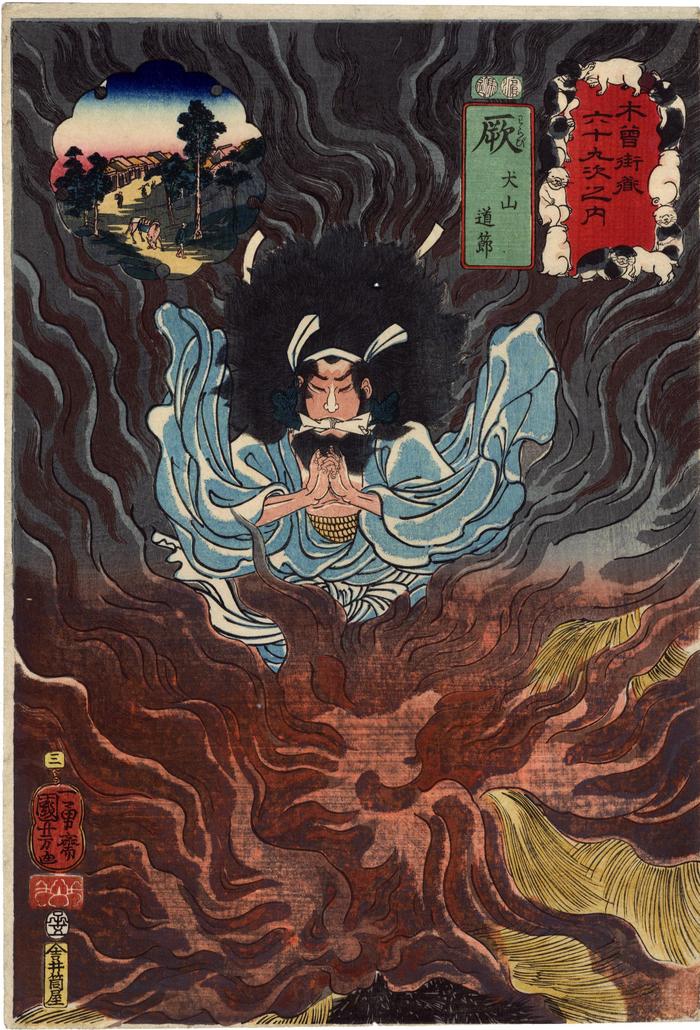Utagawa Kuniyoshi (歌川国芳) (artist 11/15/1797 – 03/05/1861)
No. 3 (三) Warabi (蕨)i: Inuyama Dōsetsu (犬山道節) from the series Sixty-nine Stations of the Kisokaidō (Kisokaidō rokujūkyū tsugi no uchi - 木曾街道六十九次之内)
05/1852
10 in x 14.75 in (Overall dimensions) Japanese color woodblock print
Signed: Ichiyūsai Kuniyoshi ga
一勇斎国芳画
Artist's seal: kiri
Publisher: Izutsuya Shōkichi
(Marks 188 - seal 21-060)
Date seal: 5/1852
Censor seals: Hama and Magome
Number: 三 (3)
Museum of Fine Arts, Boston
British Museum
Tokyo Metropolitan Library
The National Museum of Asian Art
Lyon Collection - a different Kuniyoshi approach to this figure
Hiroshige Museum of Art
Musée Cernuschi
Musée d’art et d’histoire, Ville de Genève
Lyon Collection - a similar earlier print by Kuniyoshi of Kidōmaru
Hiroshige Museum of Art, Ena
Allen Memorial Art Museum, Oberlin College
Tateyama City Museum (via Cultural Heritage Online) "Magic enters the story of The Eight Dogs of Satomi with the introduction of the second of the eight heroes, Inuyama Dōsetsu, who represents the virtue of loyalty. Like his fellow heroes Inuzuka Shinō... he has the word for 'dog' (inu in his family name, and he was born holding a Buddhist rosary bead with his special virtue inscribed on it....
Dōsetsu is posing as a wandering ascetic named Jakumaku Dōjin Kenryū in order to raise money. As a master of fire magic, he is able to walk through flames without being harmed, and he collects offerings in return for performing this miracle. The place-name Warabi puns on 'straw fire,' and the fire is vividly depicted by Kuniyoshi in one of the most striking prints in the series. The ascetic, dressed in white clothing with a white scarf on his head, makes a secret magical gesture with his hands and clutches pine sprigs wrapped in paper in his mouth [an aomatsuba] as part of the spell. As he sits on an altar in the midst of the raging fire, the local people throw in their offerings of money, and he disappears in the flames.
Meanwhile, Hamaji, the fiancée of Inuzuka Shino, has been kidnapped by the villain Samojirō, who has also stolen Shino's precious sword Murasamemaru... Hamaji and Samojirō arrive in Marutsukayama just afater the fire ceremony. Samojirō proposes to Hamaji, who plays along with him just long enough to grab Murasamemaru and to try to stab him with it. Samojirō easily overpowers her, but suddenly the ascetic Kenryū, who is really Hamaji's brother Inuyama Dōsetsu, reappears in the nick of time to kill Samojirō and save Hamaji."
Illustrated
1) in a full-page color reproduction and quoted from: Utagawa Kuniyoshi: The Sixty-nine Stations of the Kisokaidō by Sarah E. Thompson, Pomegranate Communications, Inc., 2009, page 22, no. 3.
2) in color in Heroes and Ghosts: Japanese Prints by Kuniyoshi 1797-1861 by Robert Schaap, Hotei Publishing, 1998, page 104, no. 90.
3) in a small black and white reproduction in Japanese Woodblock Prints: A Catalogue of the Mary A. Ainsworth Collection, by Roger Keyes, Allen Memorial Art Museum, Oberlin College, 1984, p. 190, #490.
4) in a small black and white reproduction in Kuniyoshi: The Warrior Prints by B. W. Robinson, 1982, p. 30, fig. 29, S74.4.
5) in a small black and white reproduction in Masterful Illusions: Japanese Prints in the Anne van Biema Collection by Ann Yonemura, the Smithsonian Institution with the University of Washington Press, 2002, #262, p. 339.
6) in color in Utagawa Kuniyoshi: 342 Color Paintings [sic] of Utagawa Kuniyoshi by Jacek Michalak, Kindle Edition, 2022, unpaginated.
****
The title cartouche for this particular print has a border made up of puppies or dogs, which ties it thematically to the magical figure surrounded by flames.
****
For an interesting comparison look at #708 in the Lyon Collection. Also created by Kuniyoshi.
landscape prints (fūkeiga 風景画) (genre)
magicians (mahōtsukai - 魔法使い) (genre)
Izutsuya Shōkichi (井筒屋庄吉) (publisher)
Hakkenden (The Eight Dog Heroes - 八犬伝) (genre)
Kyokutei Bakin (曲亭馬琴) (author)
